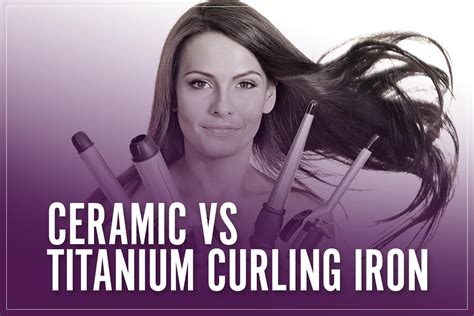Introduction

Choosing the right curling iron material can significantly impact the health of your hair and the quality of your curls. With so many options available in the market, it can be overwhelming to determine which material is the best for your needs. In this article, we will explore the different types of curling iron materials, their advantages, and disadvantages to help you make an informed decision.
Types of Curling Iron Materials
1. Titanium
- Benefits:
- Heats up quickly and evenly, reducing styling time.
- Lightweight and durable, making it user-friendly.
-
Produces smooth, shiny curls with minimal frizz.
-
Disadvantages:
- Can be expensive compared to other materials.
- May not be suitable for fine or damaged hair due to its high heat conductivity.
2. Ceramic
- Benefits:
- Emits negative ions, which help to seal hair cuticles and reduce frizz.
- Heats up evenly, providing consistent curls.
-
Affordable and available in a wide range of styles.
-
Disadvantages:
- May take longer to heat up than titanium.
- Not as durable as titanium, making it more prone to damage.
3. Tourmaline
- Benefits:
- Similar to ceramic, emits negative ions to reduce frizz.
- Provides gentler heat that is less damaging to hair.
-
Creates voluminous, long-lasting curls.
-
Disadvantages:
- Can be more expensive than ceramic.
- May not heat up as quickly as titanium.
4. Ionic
- Benefits:
- Releases negative ions, which neutralize positive ions in hair, eliminating static and frizz.
- Promotes hair shine and softness.
-
Can be paired with any of the above materials for added benefits.
-
Disadvantages:
- Not a standalone material, must be combined with another material.
- Can be more expensive due to the additional technology.
5. Gold
- Benefits:
- Luxurious and stylish, providing a professional-quality finish.
- Distributes heat evenly, preventing hot spots.
-
Can be used on all hair types, including fine or damaged hair.
-
Disadvantages:
- Most expensive material option.
- May not heat up as quickly as other materials.
The best material for a curling iron depends on your individual hair type, styling preferences, and budget.
- For fine or damaged hair: Tourmaline or gold with ionic technology is recommended to reduce heat damage and promote hair health.
- For thick or coarse hair: Titanium or ceramic will provide quick heating and long-lasting curls.
- For frizzy or static hair: Ionic technology paired with any of the above materials will help to eliminate frizz and enhance shine.
- For those on a budget: Ceramic is a cost-effective option that offers good performance and durability.
Common Mistakes to Avoid
- Using the wrong temperature setting: Excessive heat can damage hair. Use the lowest temperature setting that still produces satisfactory results.
- Over-styling: Curling your hair too often or for extended periods can lead to breakage. Limit styling sessions to once or twice a week.
- Neglecting heat protectant: Always apply a heat protectant spray before using a curling iron to shield your hair from heat damage.
The material of your curling iron plays a crucial role in the following:
- Heat distribution: Different materials conduct heat differently, affecting how evenly your hair is heated.
- Hair damage: Some materials are more gentle on hair than others, reducing the risk of breakage and split ends.
- Curl longevity: The material can impact how long your curls hold their shape, with some materials providing longer-lasting results.
- Styling versatility: Certain materials, such as titanium, allow for a wider range of curl styles, from tight ringlets to loose waves.
- Healthy, damage-free hair: A suitable material minimizes heat damage and promotes hair health.
- Perfect, long-lasting curls: The right material ensures even heat distribution and curl longevity, giving you salon-quality results at home.
- Versatile styling options: Different materials allow you to create a variety of curl styles, enabling you to experiment with your look.
- Peace of mind: Knowing that your curling iron is made from high-quality materials gives you confidence in its performance and durability.
Conclusion
Choosing the best material for a curling iron is essential for achieving healthy, beautiful curls. By understanding the different types of materials available and their unique properties, you can make an informed decision that best meets your hair needs and styling preferences. With the right curling iron material, you can elevate your hair game and enjoy stunning, frizz-free curls every time.
| Material | Heat Conductivity | Hair Health | Curl Longevity |
|---|---|---|---|
| Titanium | High | Fair | Good |
| Ceramic | Moderate | Good | Fair |
| Tourmaline | Low | Excellent | Good |
| Ionic (combined) | N/A | Excellent | Good |
| Gold | Low | Excellent | Excellent |
| Hair Type | Recommended Materials |
|---|---|
| Fine or damaged | Tourmaline, gold |
| Thick or coarse | Titanium, ceramic |
| Frizzy or static | Ceramic, tourmaline, ionic |
| Hair Type | Ideal Temperature Setting |
|---|---|
| Fine or damaged | 300-350°F |
| Normal | 350-400°F |
| Thick or coarse | 400-450°F |
| Material | Model | Features |
|---|---|---|
| Titanium | ghd Curve Creative Curl Wand | Fast heating, adjustable temperature, ergonomic grip |
| Ceramic | Dyson Airwrap Styler | Multiple attachments for different curl styles, digital motor for even heat distribution |
| Tourmaline | BaBylissPRO Nano Titanium Tourmaline Curling Iron | Negative ions, titanium barrel for even heat, long-lasting curls |
| Ionic | Hot Tools 24K Gold One-Step Volumizer | Ionic technology, gold barrel for luxurious finish, rotating brush for easy styling |
